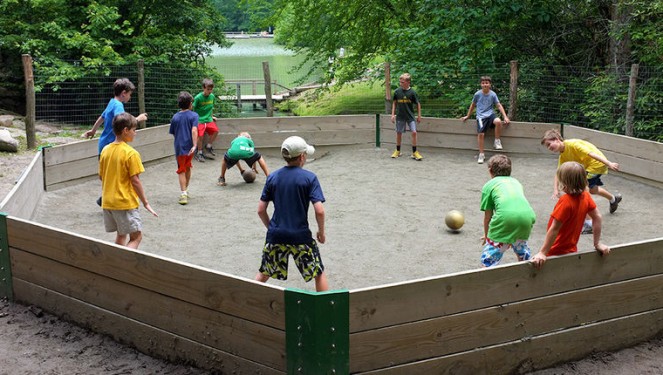Hello ladies and gents and welcome to Sports day today we are talking about

Ga-ga

Ga-ga is a variant of dodgeball that is played in a ga-ga "pit". The game combines dodging, striking, running, and jumping, with the objective of being the last person standing. Players hit the ball at each other with their hands, and are eliminated if the ball strikes them on or below the waist (occasionally the knee). The game can be played by a group of individual players or with teams, as well as in one-on-one matches. Rules, ball types, pit surfaces, and pit sizes can vary widely at different venues.
Gameplay
Ga-ga is played in a large fenced in area (usually an octagon or hexagon) called a ga-ga pit. The ga-ga pit generally consists of flat walls atop a smooth dirt, turf, sand, or rubberized surface. The ga-ga ball can vary in size and form, generally ranging from a foam dodgeball to a rubber kickball. The game begins when one player or a referee throws the ga-ga ball into the air; while their backs or hands are against the wall, the players shout "Ga" on each of the first three bounces. After three bounces, the ball is in play, and the players may leave the wall and "hit" the ball at each other in the pit. A player who is hit by the ball or breaks a rule is eliminated and must leave the game. Players may not "hit" the ball twice in a row, and a player who causes the ball to leave the pit is out. When the ball is caught in the air on a fly, the last person to hit the ball is out.
General rules
- This section does not cite any sources. Please help improve this section by adding citations to reliable sources. Unsourced material may be challenged and removed.
- A player can hit the ball with their hands, but picking up the ball and throwing it at a player is not allowed. Some versions do not permit "scooping," or curling one's fingers while hitting the ball so as to project the ball into the air. In some games, only open hand hits are allowed to prevent striking injury to small children and also to enable greater control of the ball, keeping it low and inbounds.
- If the ball touches a player anywhere on or below the knee (in some versions, below the ankle or waist), that player is eliminated from the game. If a player hits themself with the ball, accidentally or otherwise, that player is eliminated.
- A player may not hit the ball out of the pit. The penalty for breaking this rule is assigned to the last player to touch the ball before leaving the pit, rather than to the original hitter. Because this provision can result in a strategy of hitting the ball upwards to eliminate another player, the rule prohibiting scooping attempts to discourage this. In some versions, an exception is made if the ball hits a wall or the ground before leaving the pit; in this scenario, the exit is deemed to be the result of a ricochet, and the player is not eliminated.
- Holding or otherwise using the wall to assist a jump is termed "wall jumping" and is prohibited. However, some variations allow wall-jumping.
- No player may hit the ball twice in a row, unless the ball comes into contact with the wall or another player between touches. This rule is sometimes expanded to include "self-serving," which prevents the player that served the ball from being the first to touch the ball.
- If a player pops the ball up into the air, another player may catch it and ground it. The other player is then out. Some variations prohibit catching completely.
- A player must step out of the pit completely to show that they have been eliminated.
- A player must start the game with one of their feet (or some versions hands) touching the wall of the pit; however, some venues do not make it a rule to touch the pit as the game starts. One player or a referee has to throw the ball in and have it bounce thrice and chant "Ga-Ga-Ga" (Some versions use "Ga-Ga-Go", "Ga-Ga", and "Ga-Ga-Ball", among others). If a player removes their foot (or hand) off the wall before or during the chant, they are eliminated.
- The winner of the last game has the right to serve to start the next game.
- Other rules may be added as necessary, and some may choose to play without all of the above rules. Additional rules that vary in frequency of implementation include the prohibition of blocking (using one's hands as a barrier between the ball and one's feet, rather than jumping), crouching, playing on the ground, and rolling. In other variations, an additional ball may enter play towards the end of the game if the two or three remaining players are making slow progress. Commonly, there will be a 20-second count down when play is too slow and only 2 or 3 players remain. At the end of the countdown, a new game is started.
I dont know about you but I want to play that haha i hope you liked this post and as always have a chilled day from the viking
Comments
Post a Comment